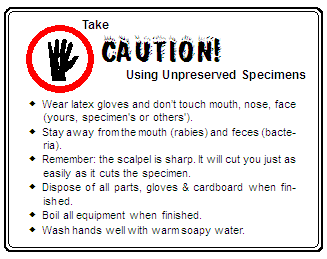Teaching High
School Biology

by Kym Wright

 Contemplating biology for high
school science, I wondered how to teach the labs. How would I handle dissection?
Where to get the materials, specimens, equipment, supplies? I queried biology
teachers and asked around home school meetings. Not to be daunted by teaching
this subject, I researched, read, looked into, asked others, then just did it!
Here are some ways I found to make the teaching of biology, and especially
dissection, a little easier.
Contemplating biology for high
school science, I wondered how to teach the labs. How would I handle dissection?
Where to get the materials, specimens, equipment, supplies? I queried biology
teachers and asked around home school meetings. Not to be daunted by teaching
this subject, I researched, read, looked into, asked others, then just did it!
Here are some ways I found to make the teaching of biology, and especially
dissection, a little easier.
Pick & Choose
First of all, remember that the schools don�t teach everything in the book; they
skim, pick and choose. I talked with a mother whose son took Biology in a
prestigious local public high school. For the whole school year, they dissected
one frog. Ditto on a nearby private school. They just don�t delve into much. So
I decided not to get bogged down trying to master it all.
Some may wonder: Why do we have to dissect anyway? If the schools aren�t doing
much, why should I? A better question is, �Should our standard be set by the
school system?� If college is in your child�s future, he is sure to study
biology there, in more detail. This gives him a head start. Also, I heard of one
homeschool student who had to return a college scholarship because her high
school biology and chemistry did not include lab courses. That hits where it
hurts. Pre-med, veterinary students and those with science majors will benefit
from as much hands-on dissection as they can acquire.
I like my children to have a working knowledge of anatomy (inner structure),
physiology (body processes), and to understand the interrelatedness of parts and
systems. It is an awesome realization to discover how and that God did all this.
When we dissected our first cow eye, we saw the optic nerve and all the other
little nerves that are the sole reason for our sight. I told the children that
if I had designed the body, I would have left off these seemingly insignificant
little strands of fiber. They are very small, but mean so much. And the
iridescence of the retina is amazing. Something that is virtually hidden was
designed with such beauty and intricate detail.
 Tools
Tools
For each of our children, we have bought a basic dissection kit for under $10.
The case contains: scalpel, scissors, forceps (tweezers), pipette (eyedropper),
bent and straight dissecting needles and a ruler. You could easily substitute
some of these items, with a sharp scalpel being a �must.� Additionally, you need
pins to hold the specimen down, magnifying glass, a pad to protect the working
surface and for ease of cleanup, and latex gloves. We have used cardboard
covered with newspaper instead of a dissection pad. To clean up, we just toss
it!
 Specimens
Specimens
Forget the days of obnoxious formaldehyde! Modern nontoxic specimens don�t
need special ventilation and are safe to use. First dissections are usually
a frog, but there is so much else to explore! Covering the spectrum of
anatomical structures, Zoology Survey sets contain 6-10 specimens ranging
from small to large animals or organs for under $10 per kit. For further
study, we dissected sheep organ parts and a Comparative Anatomy nine-pack.
There are also places to order kits and science experiments in a box � they
come to your door; all you add is the children!
Some are concerned about using animals from unknown sources, either hunted
or road-kill. Our veterinarian cautioned us about touching the mouth
(rabies) and the feces (bacteria). However, when hunters work with their
prize kills, they are exposed to more germs, without the luxury of latex
gloves! With care and caution, there shouldn�t be a problem (see box).
Books & Supplies
For text and lab books we found the usual Christian school suppliers and
homeschool sources. However, a resource we found most helpful was the book
How to Dissect by William Berman (available in most public libraries). It
has information, instructions, and labeled diagrams. It was helpful for many
dissections, however some of the specimens we bought came with a thorough
dissection guide for that specific anatomical organ. Just ask when you place
your order with a biological supplier. (See Suppliers list.)
During our Reptile unit study, we had a turtle to dissect. Our first
surprise came when we couldn�t open the shell. It doesn�t come apart! None
of our resource books had turtle dissection instructions, so we were on our
own � until we went on-line. We found some interesting websites that have a
varied assortment of dissection lab sheets and directions (see On-line
Finds). We printed the one for the turtle analysis, followed their
step-by-step approach, and had that shell popped open in a snap.
 Setting the Atmosphere
Setting the Atmosphere
Now, what do you do if you have a reticent child, a squeamish student who is
not the least bit intrigued? I had one who was hesitant at first. After
watching our oldest child performing a dissection, and actually assisting
with the fetal pig (whom they named �Wilbur� ala Charlotte�s Web), she was
excited and ready. Another tactic for the not-so-thrilled would be to start
a co-�p, or a science lab class with other home school families, and include
some children that are eager to perform these labs. Enthusiasm is catching.
Now, if the teacher is the reluctant learner, then you need a substitute. Barter
with another homeschool mom, entice a biology teacher to run a lab for your
children (and consider asking other homeschool children to join), or let the
children wade through it on their own. Just remind them to be careful with the
sharp instruments. One informational introduction is the �Virtual Frog
Dissection� on the Internet (see On-line Finds). It will never be the same as
dissecting the specimen in the flesh, but could help with the understanding. Or
use the on-line tutorial to help the student walk through the hands-on process
without the teacher there to coach.
For starters, the first specimen should be some innocuous body part: the kidney
or the heart, but surely not the eyeball. For the faint of heart with a vivid
imagination, the eye seems to stare at you during the entire lab. So, if you
have a high school student that needs biology with lab credit, don�t panic. Just
glean from these resources, and jump in.

OnLine Finds
 http://hobbs.d91.k12.id.us/www/skyline/teachers/robertsd/DISSECT.HTM
(Animal Dissection Page: earthworm, clam, crayfish, frog, grasshopper, shark,
fish, starfish, mammal, heart, turtle and bird)
http://hobbs.d91.k12.id.us/www/skyline/teachers/robertsd/DISSECT.HTM
(Animal Dissection Page: earthworm, clam, crayfish, frog, grasshopper, shark,
fish, starfish, mammal, heart, turtle and bird)
http://www-itg.lbl.gov/Frog/ (Computer-Enhanced Science Education: The Whole
Frog Project)
http://george.lbl.gov/vfrog/ (Virtual Frog Dissection Kit)
http://teach.virginia.edu/go/frog/ (Interactive Frog Dissection: Online
Tutorial)
http://www-itg.lbl.gov/vfrog/WWW.94.paper.html (Virtual Frog Dissection:
Interactive 3D Graphics Via the Web)
http://www.skio.peachnet.edu/whale/whale.html (Dissection of Lindsay the Right
Whale)
http://mail.fkchs.sad27.k12.me.us/fkchs/vpig/ (Virtual Pig Dissection)
http://www.vh.org/Providers/Textbooks/BrainAnatomy/BrainAnatomy.html (Human
Brain Dissection)
http://www.exploratorium.edu/learning_studio/cow_eye/index.html (Virtual Cow's
Eye Dissection)
http://www.bhs.berkeley.k12.ca.us/departments/Science/anatomy/cat/index.html
(Cat Dissections Online)
http://academic.uofs.edu/department/psych/sheep/ (Sheep Brain Dissection Guide)



Suppliers: Nasco, 901 Janesville Ave., Ft. Atkinson, WI 53538-0901
(800-558-9595); Science-Labs-In-A-Box, PO Box 1405, Canyon, TX 79015
(800-742-7805); Edmund Scientific, 101 E. Gloucester Pike, Barrington, NJ
08007-1380; Carolina Biological Supply Co., 2700 York Rd., Burlington, NC 27215
(800-334-5551); Tobin's Lab, PO Box 6503, Glendale, AZ 85312-6503

� Copyright and written by Kym Wright.
First published in the Florida Parent Educator's
Association newsletter.

